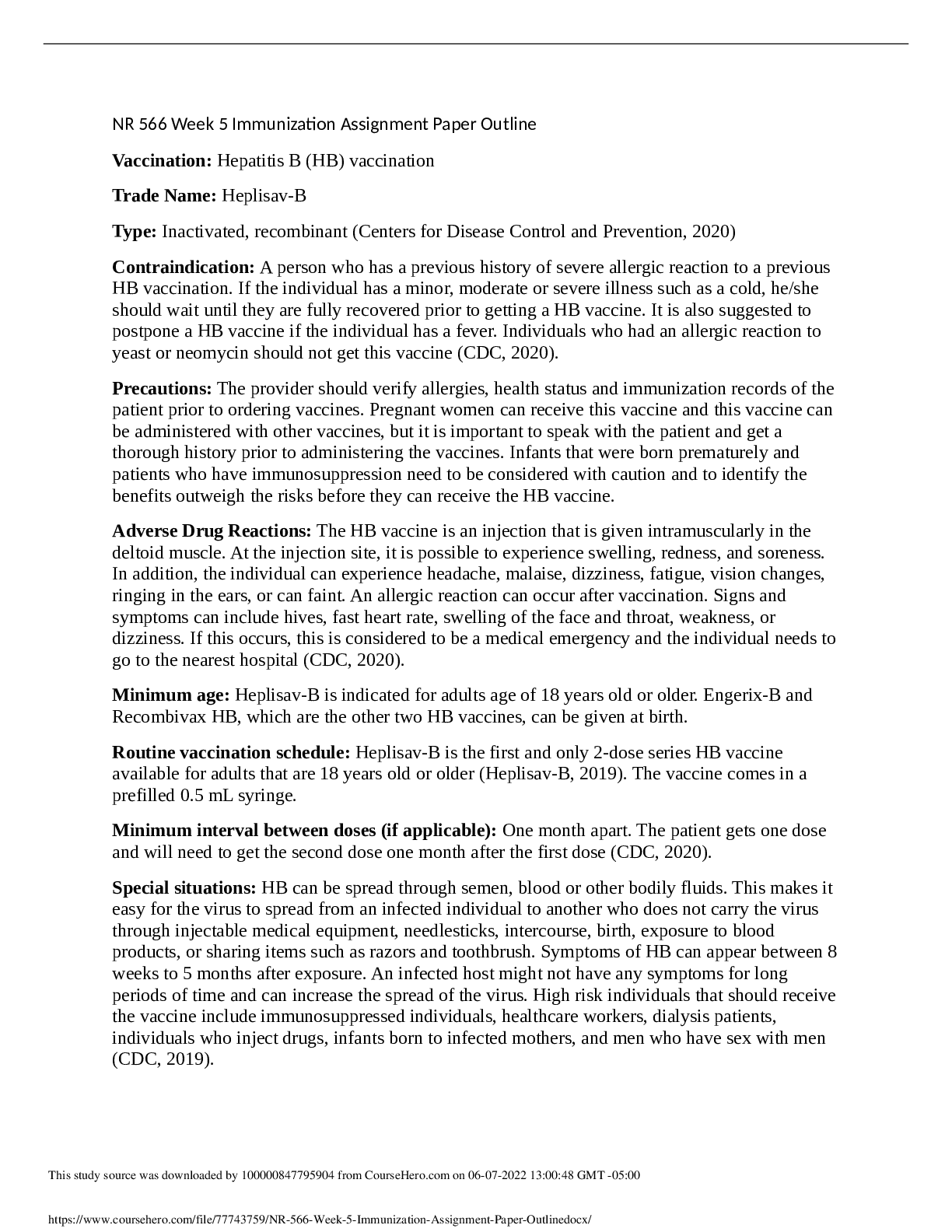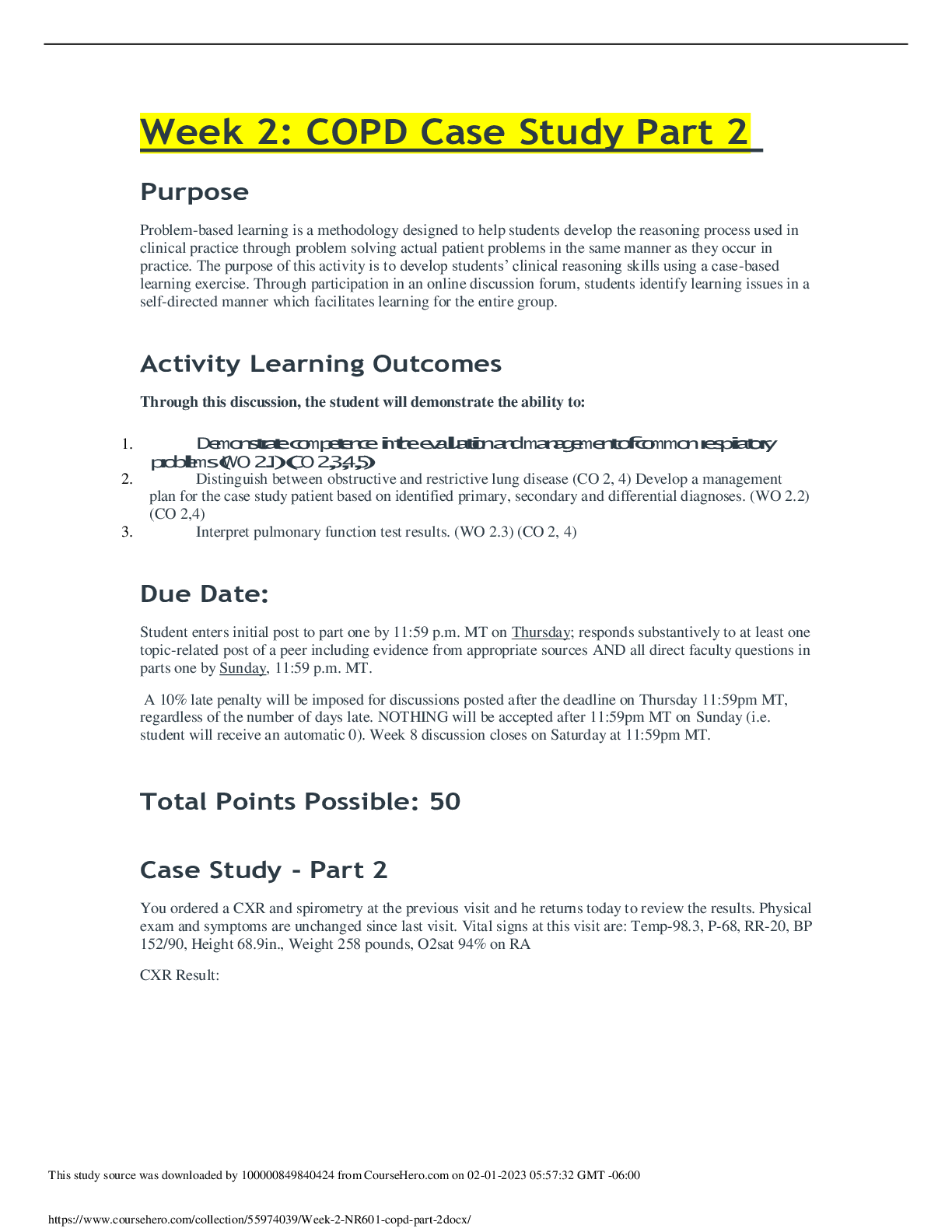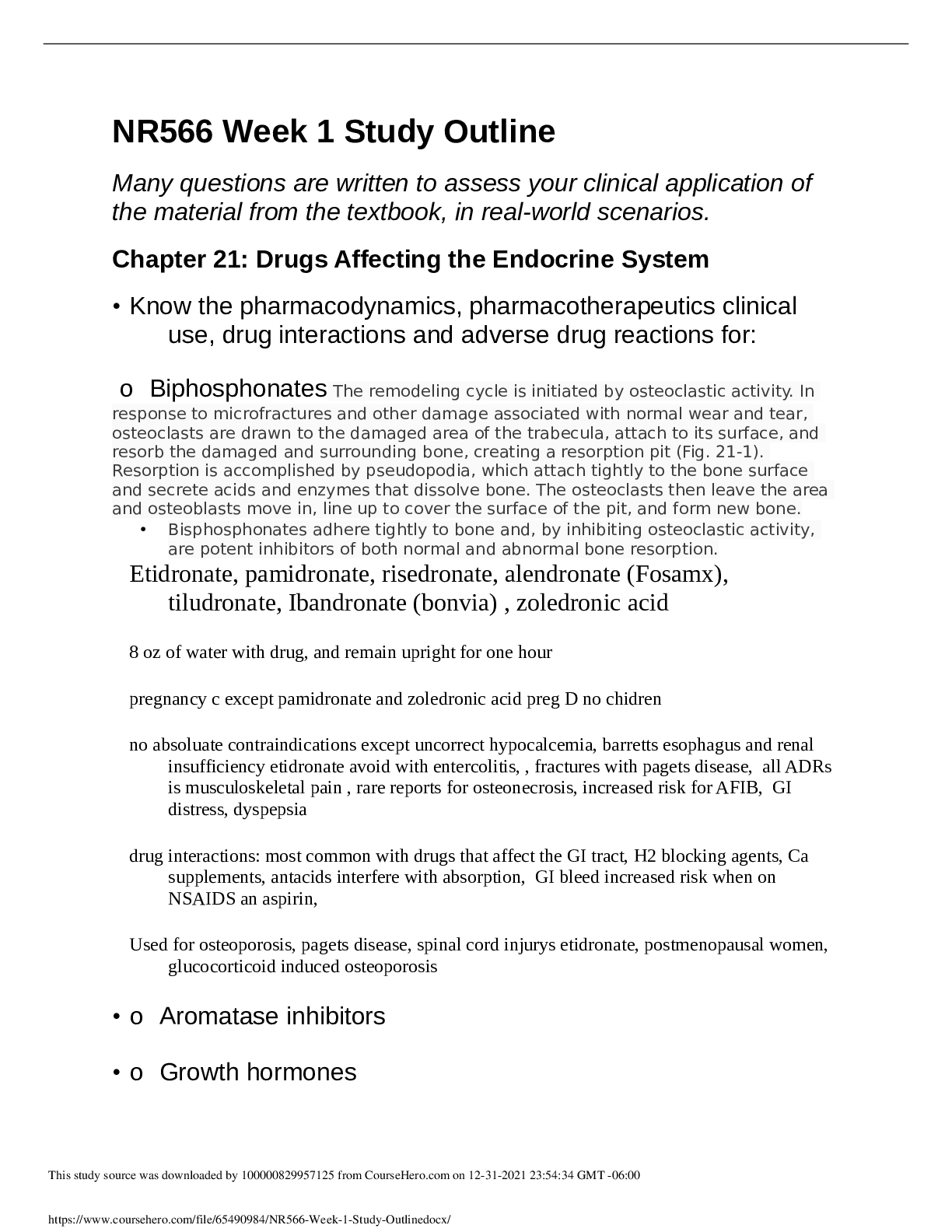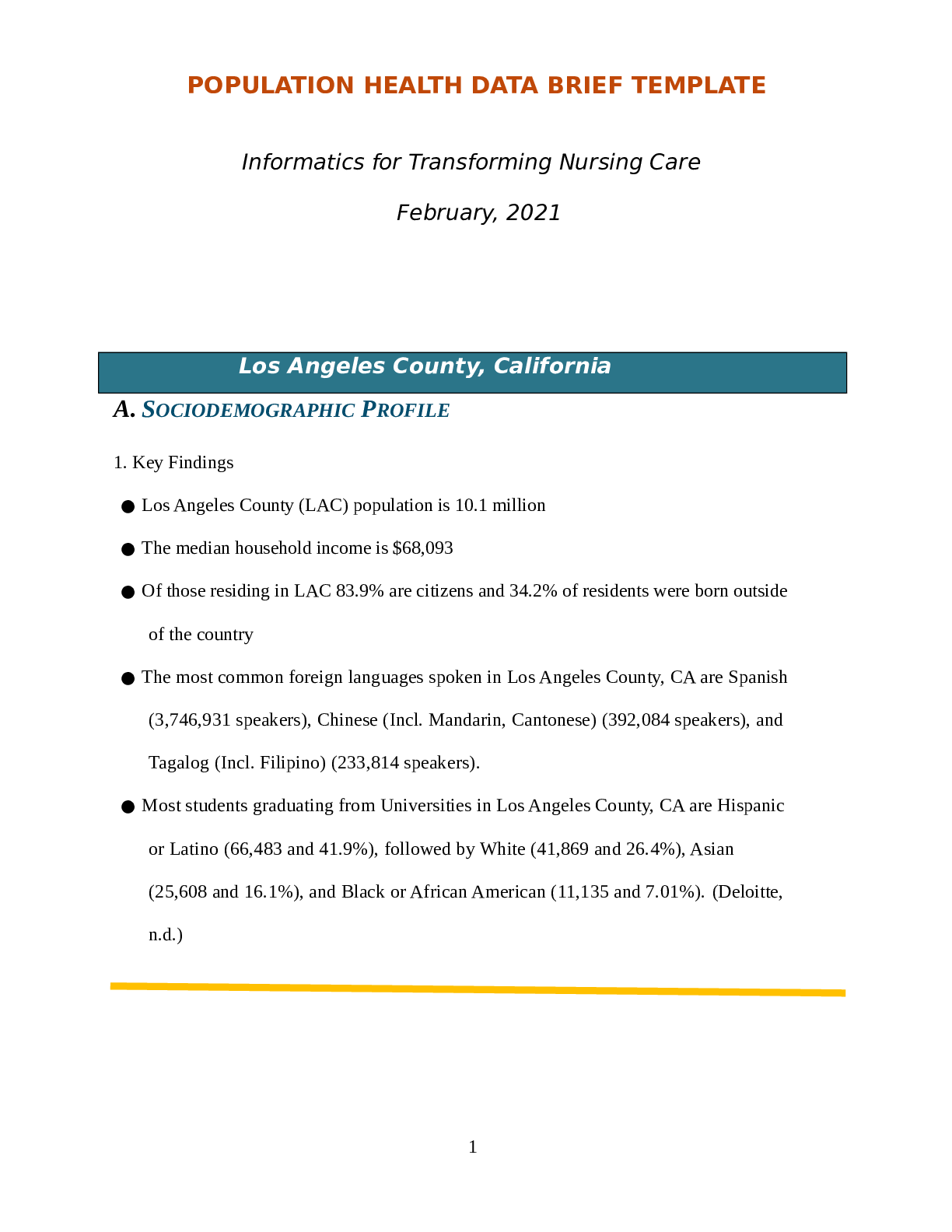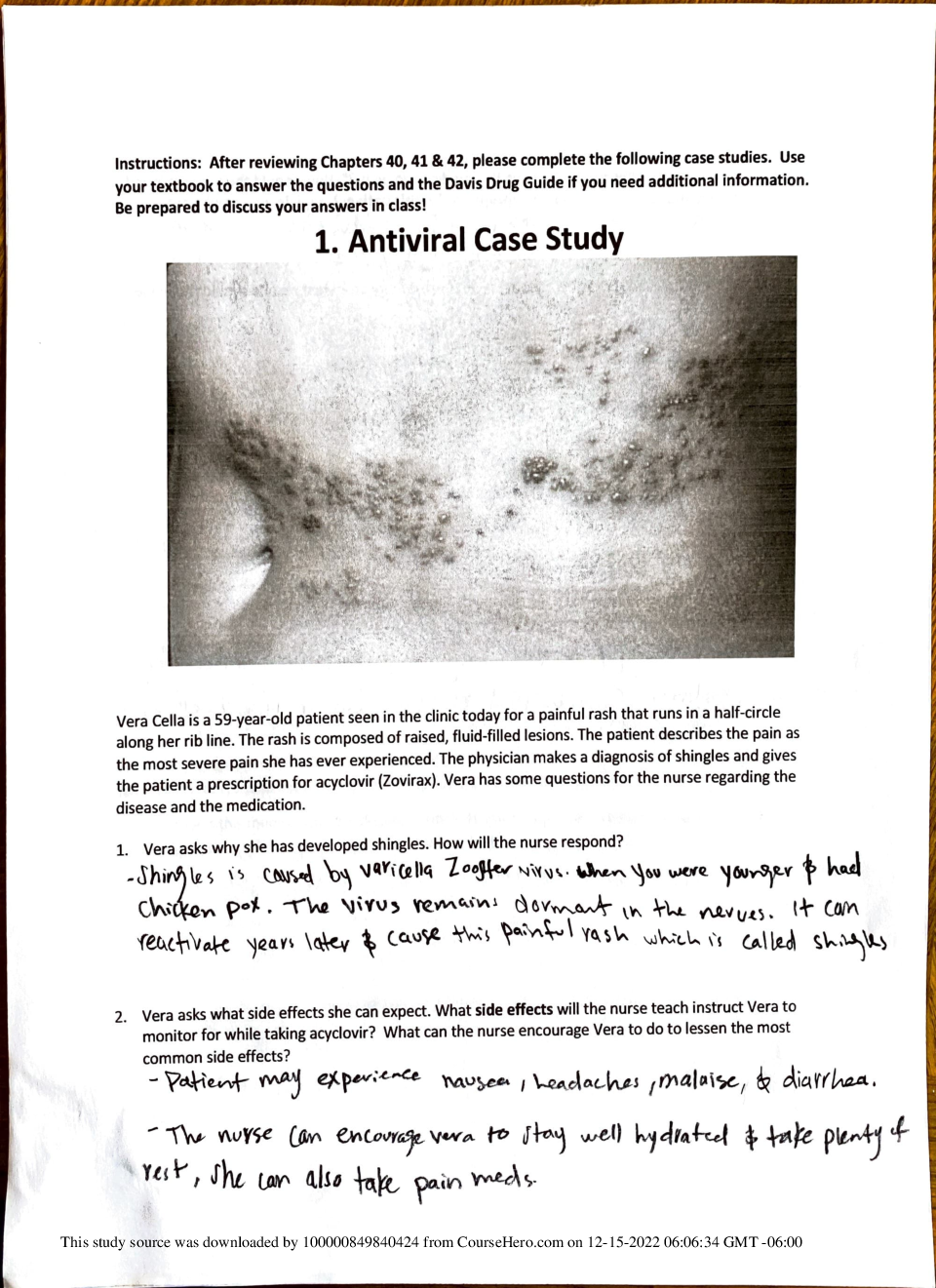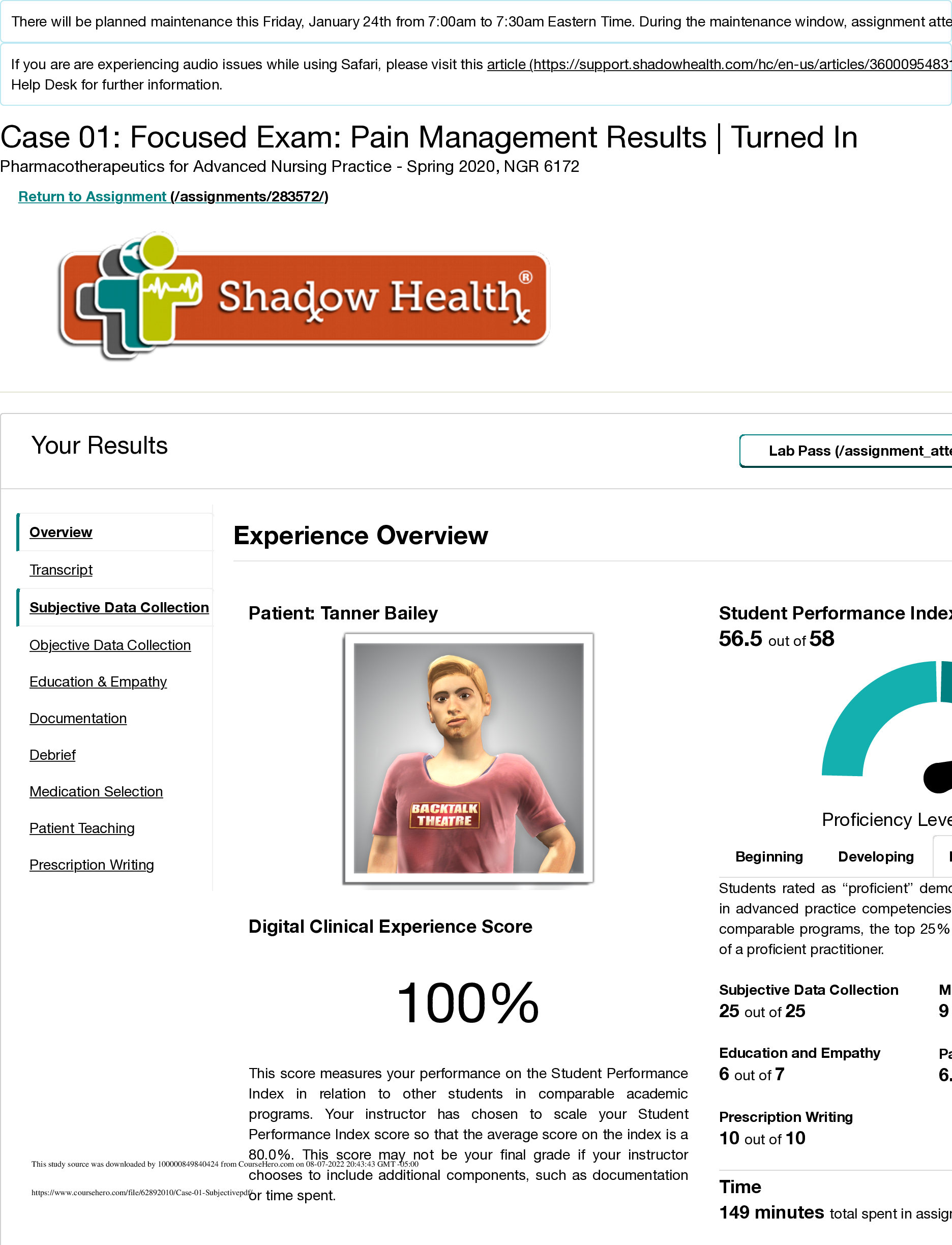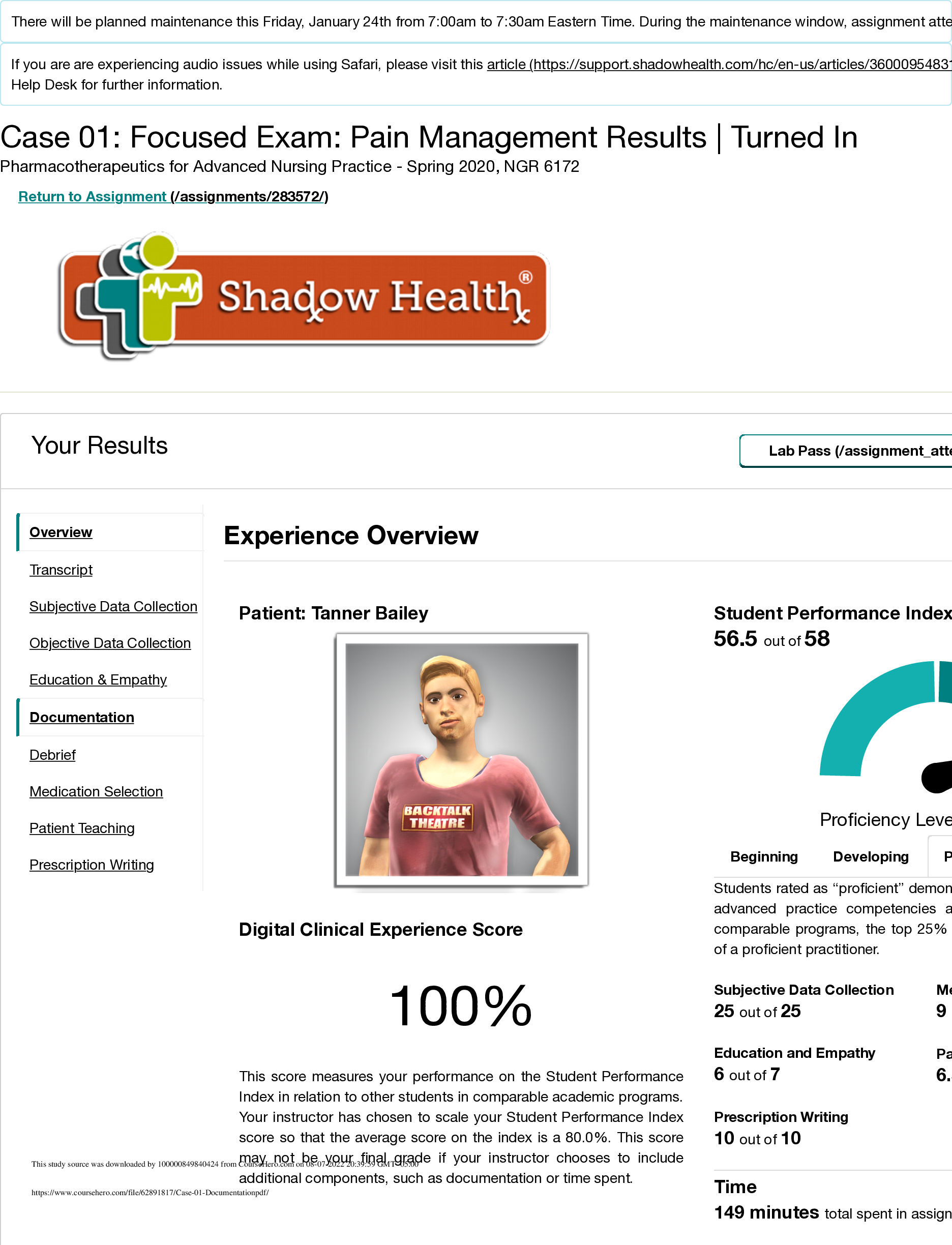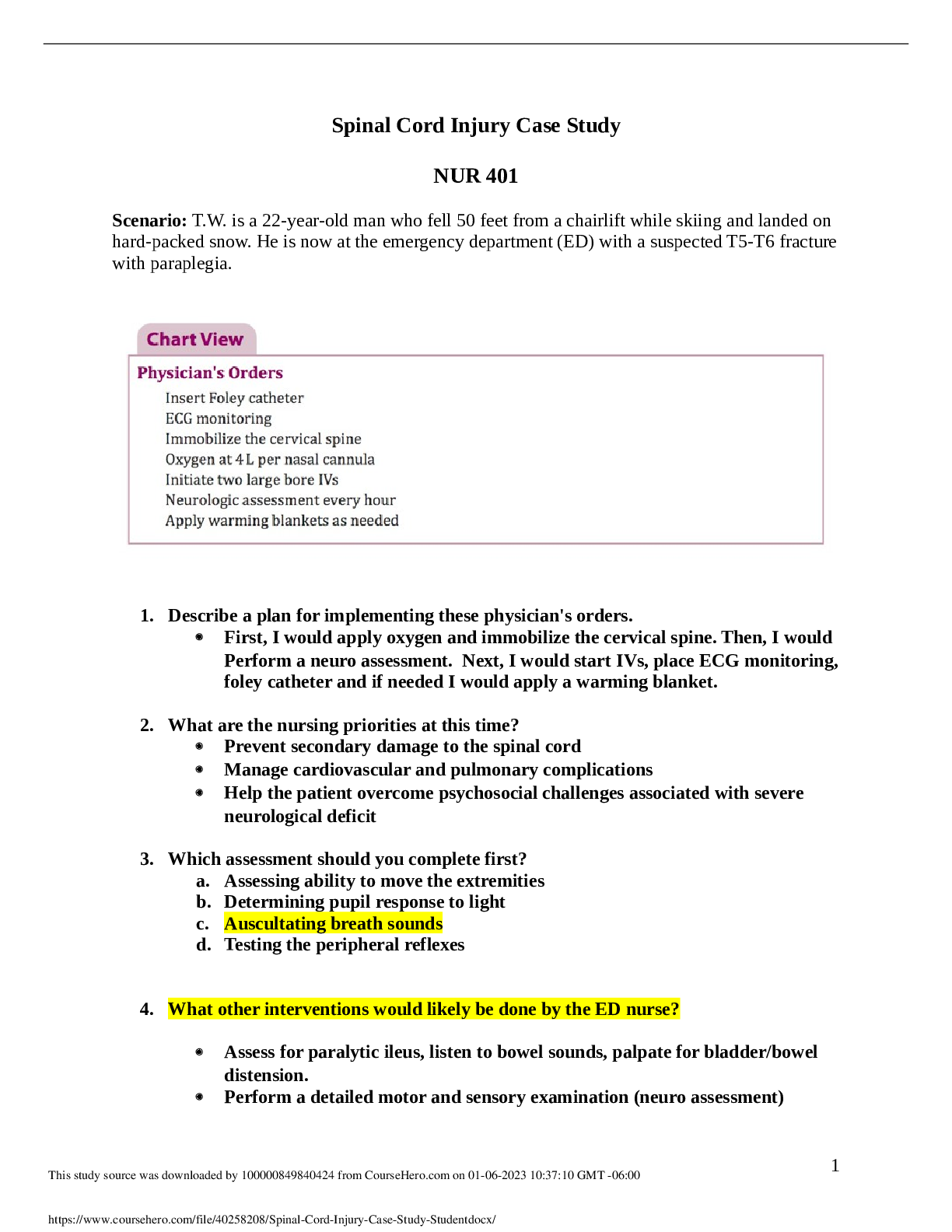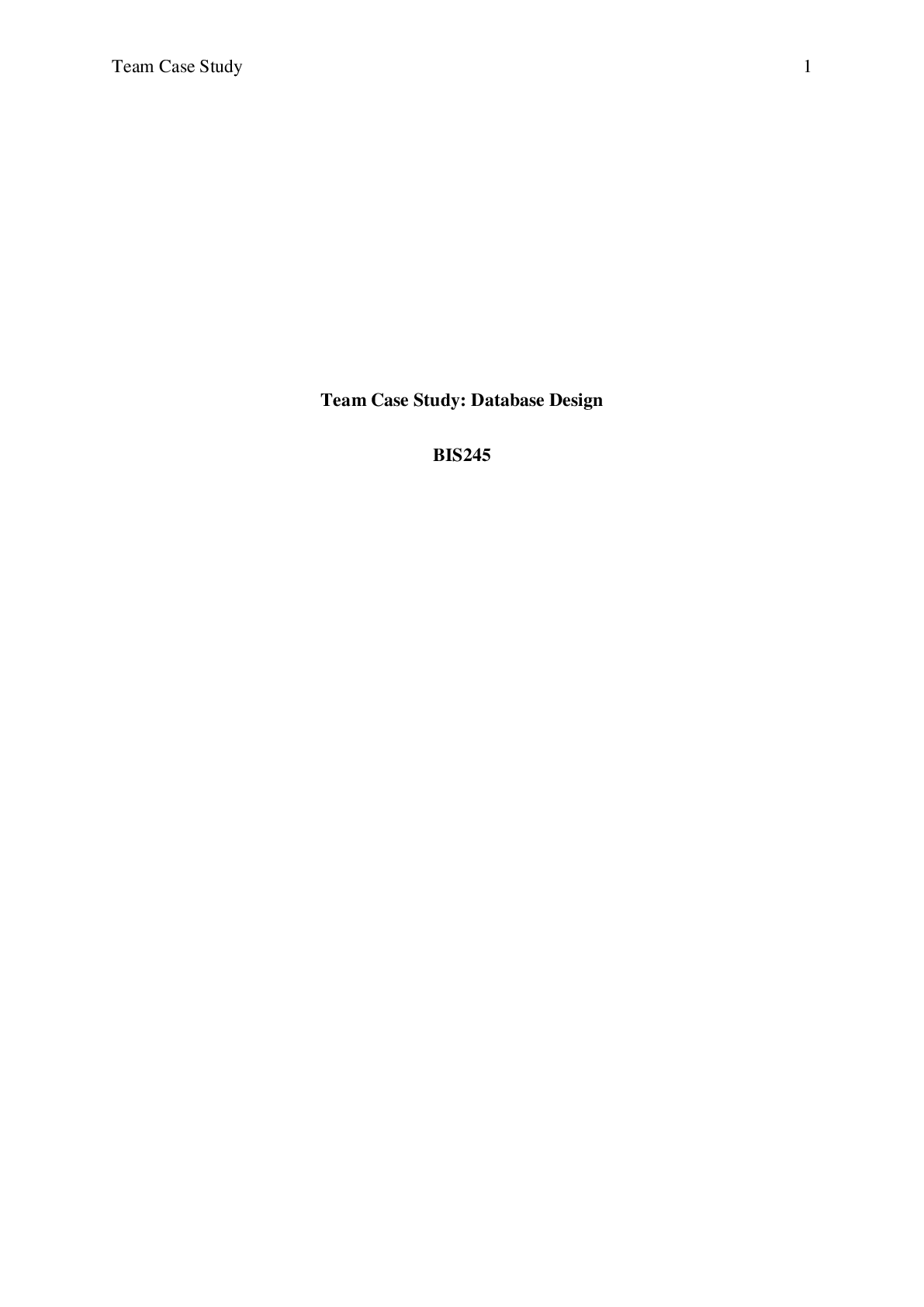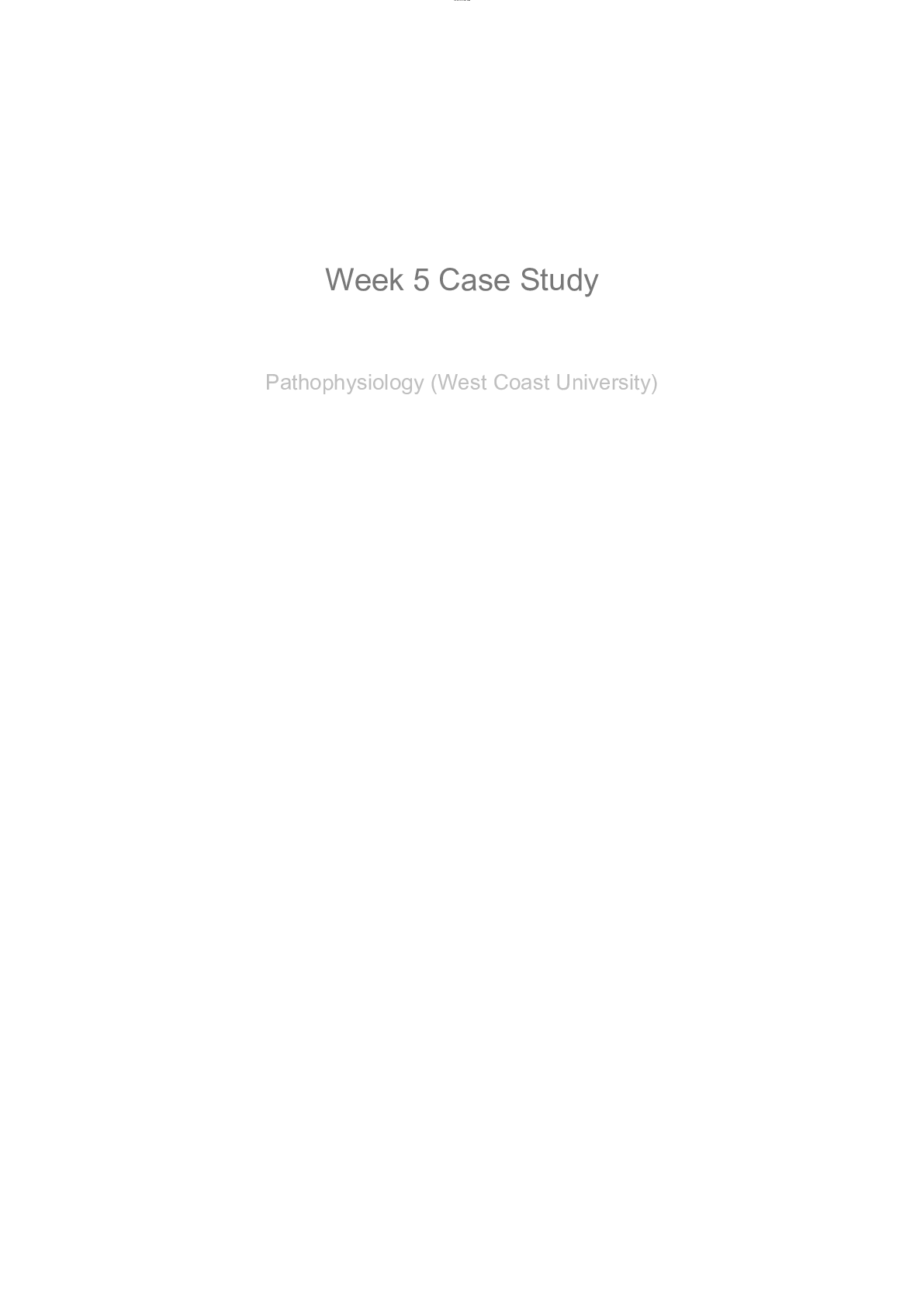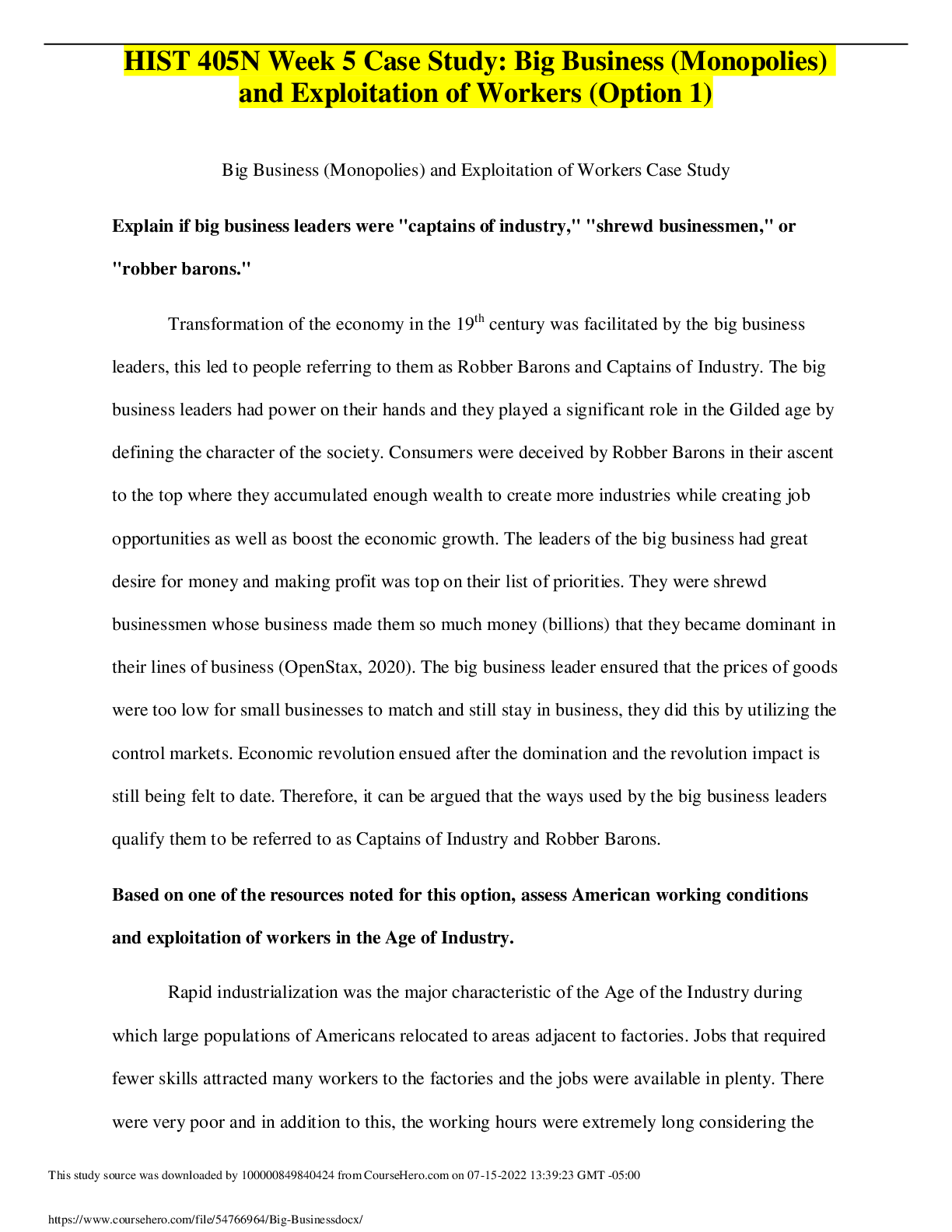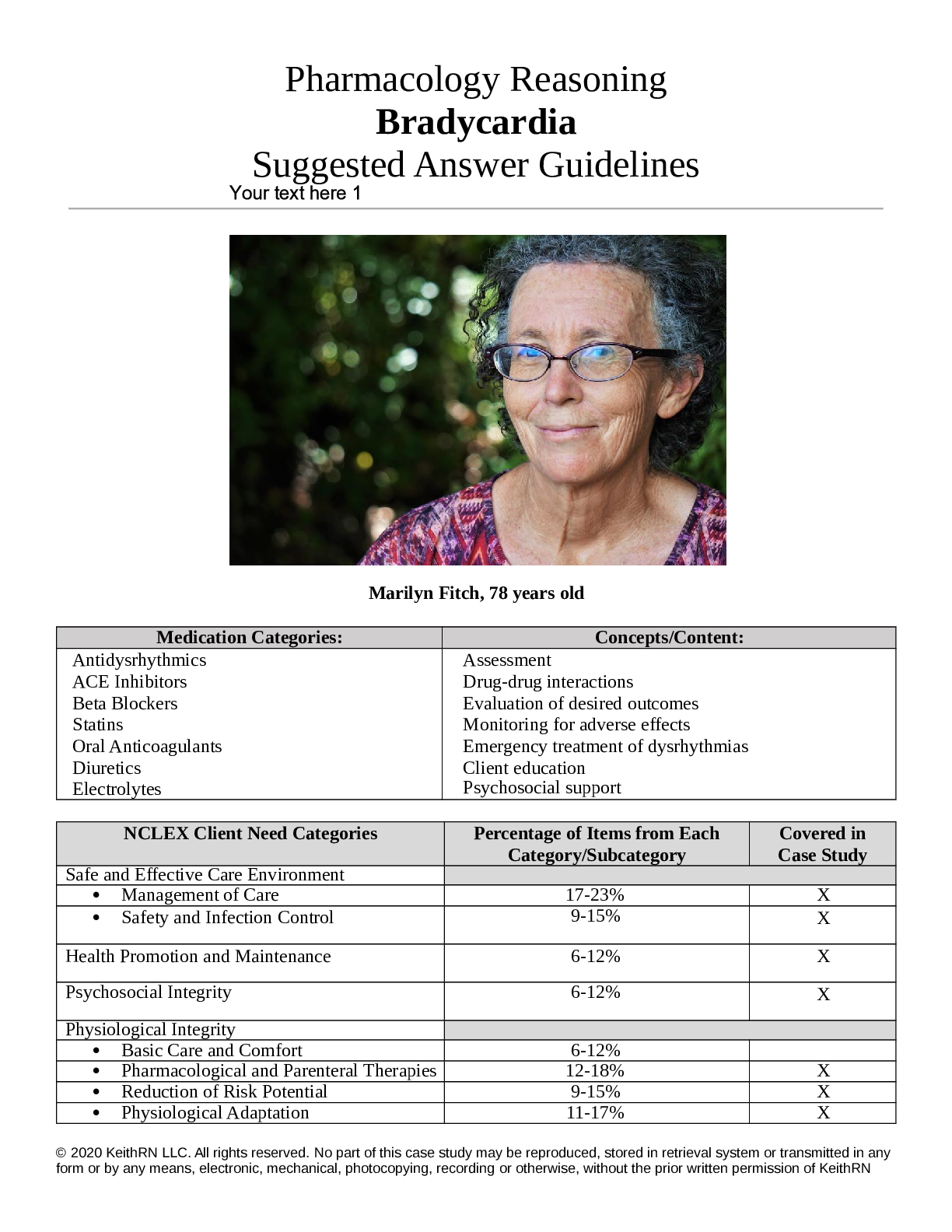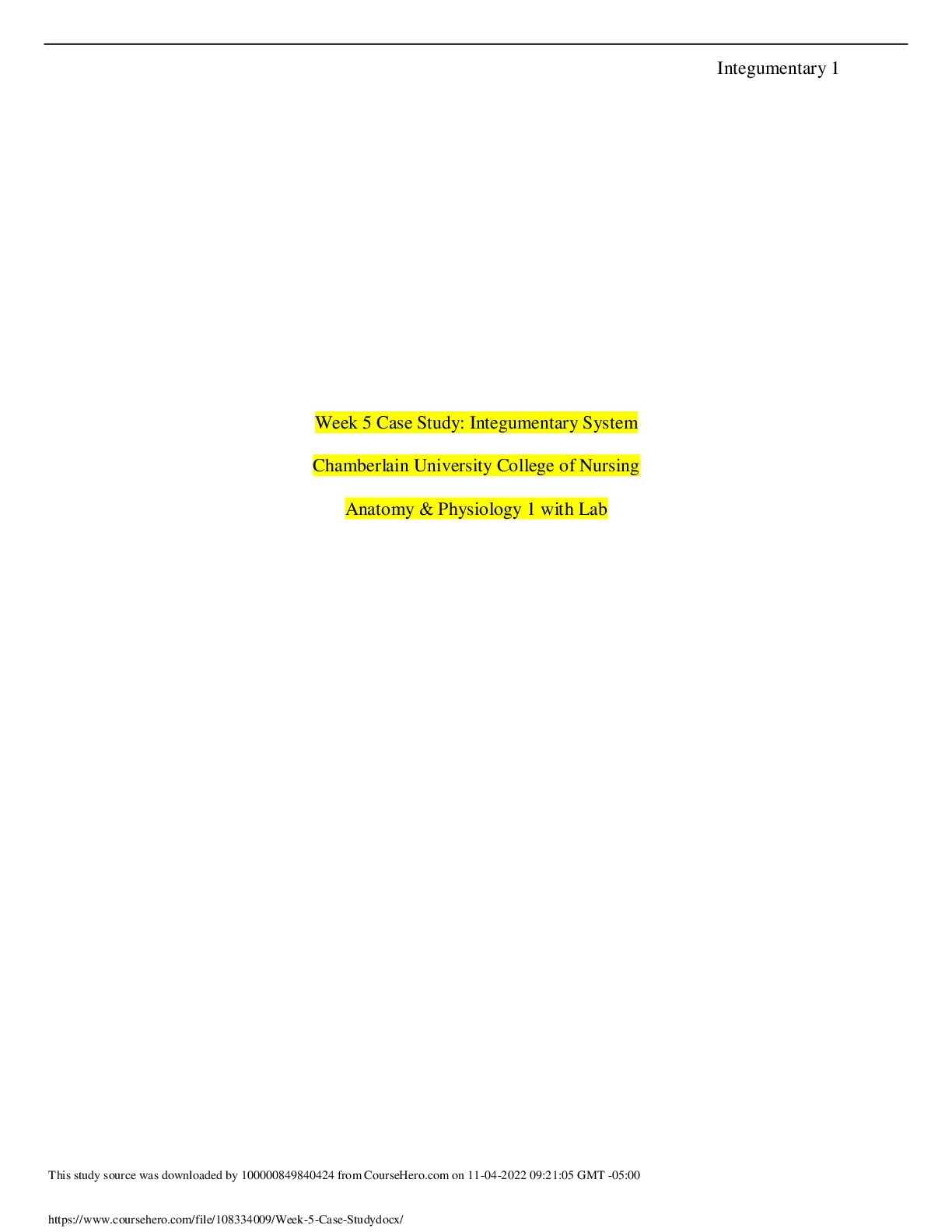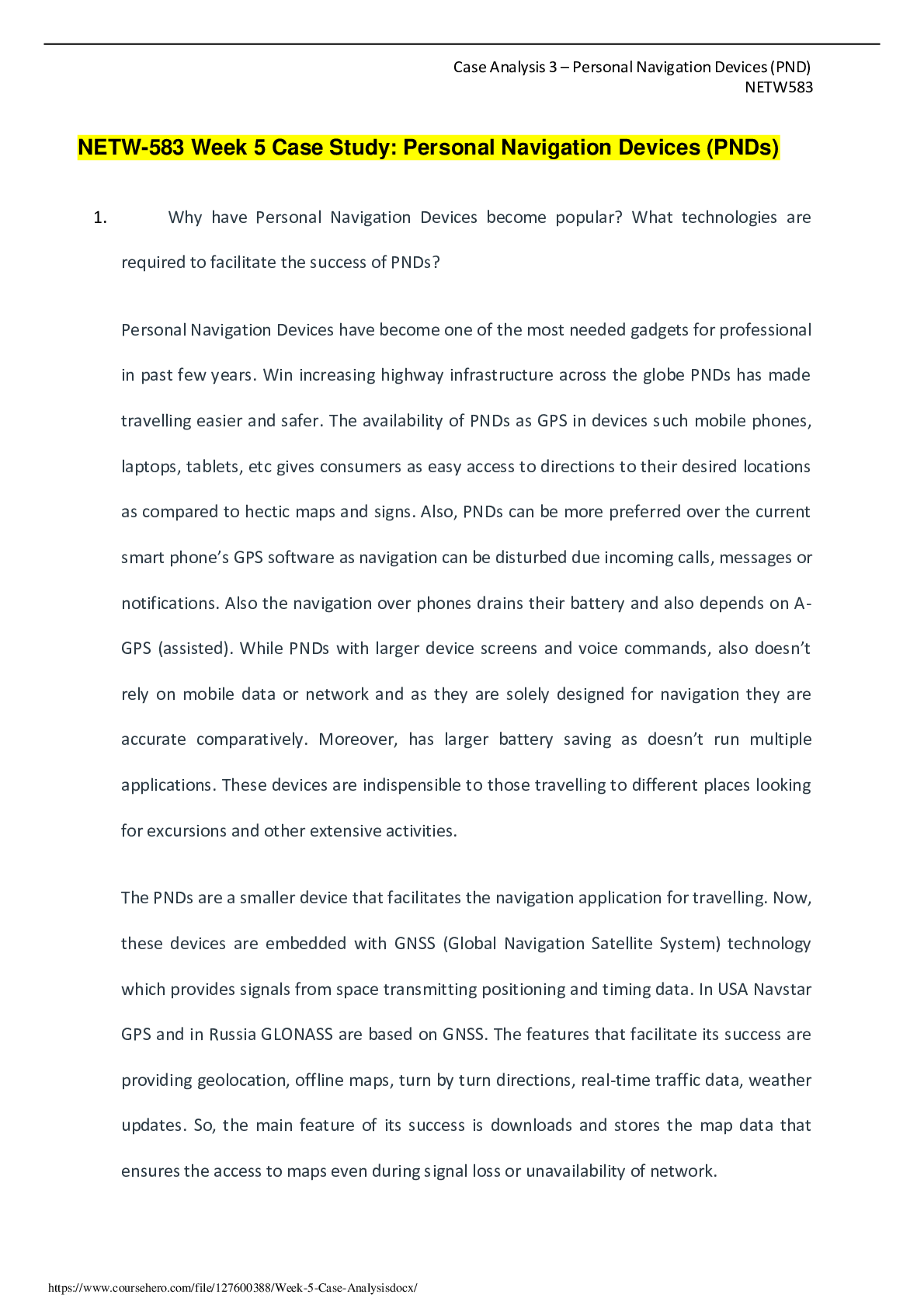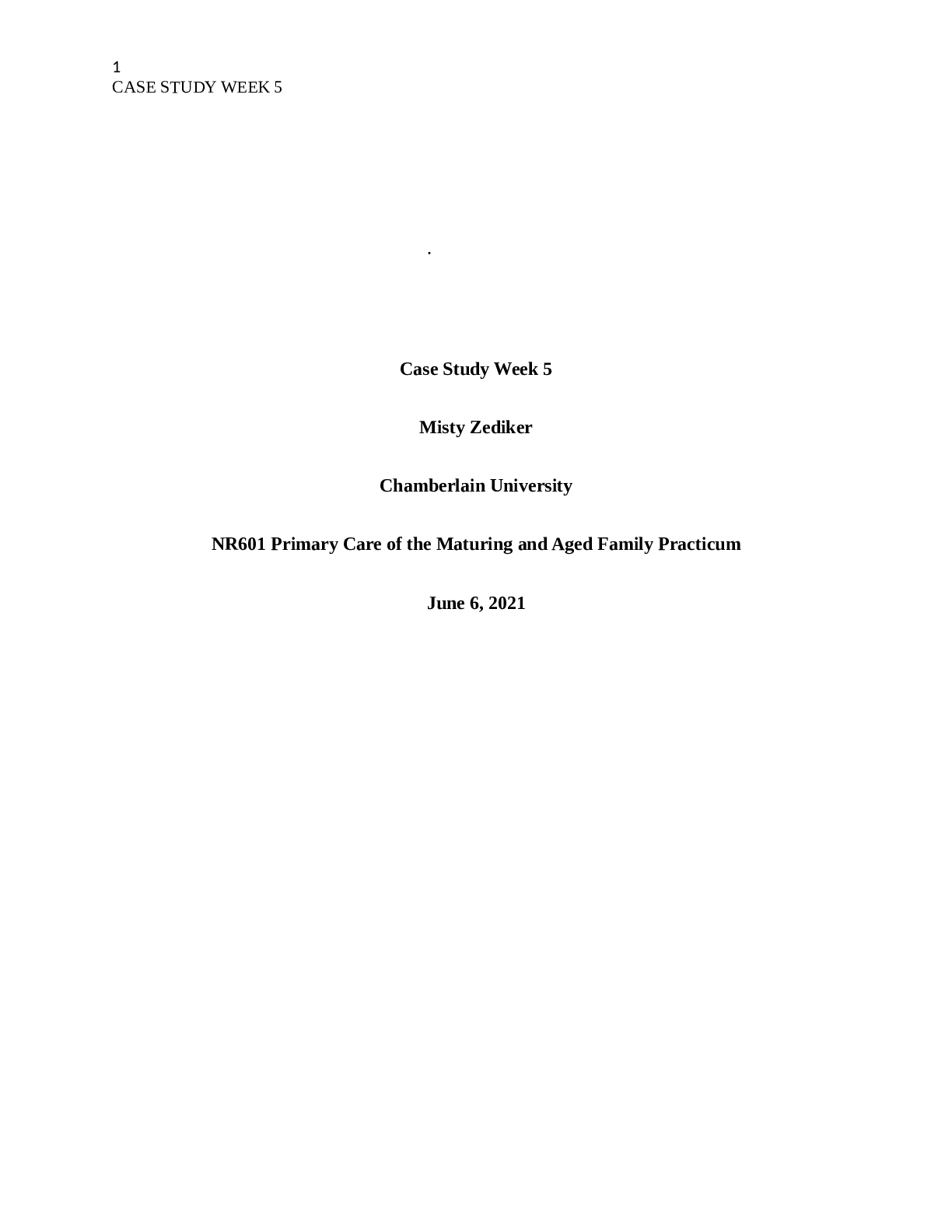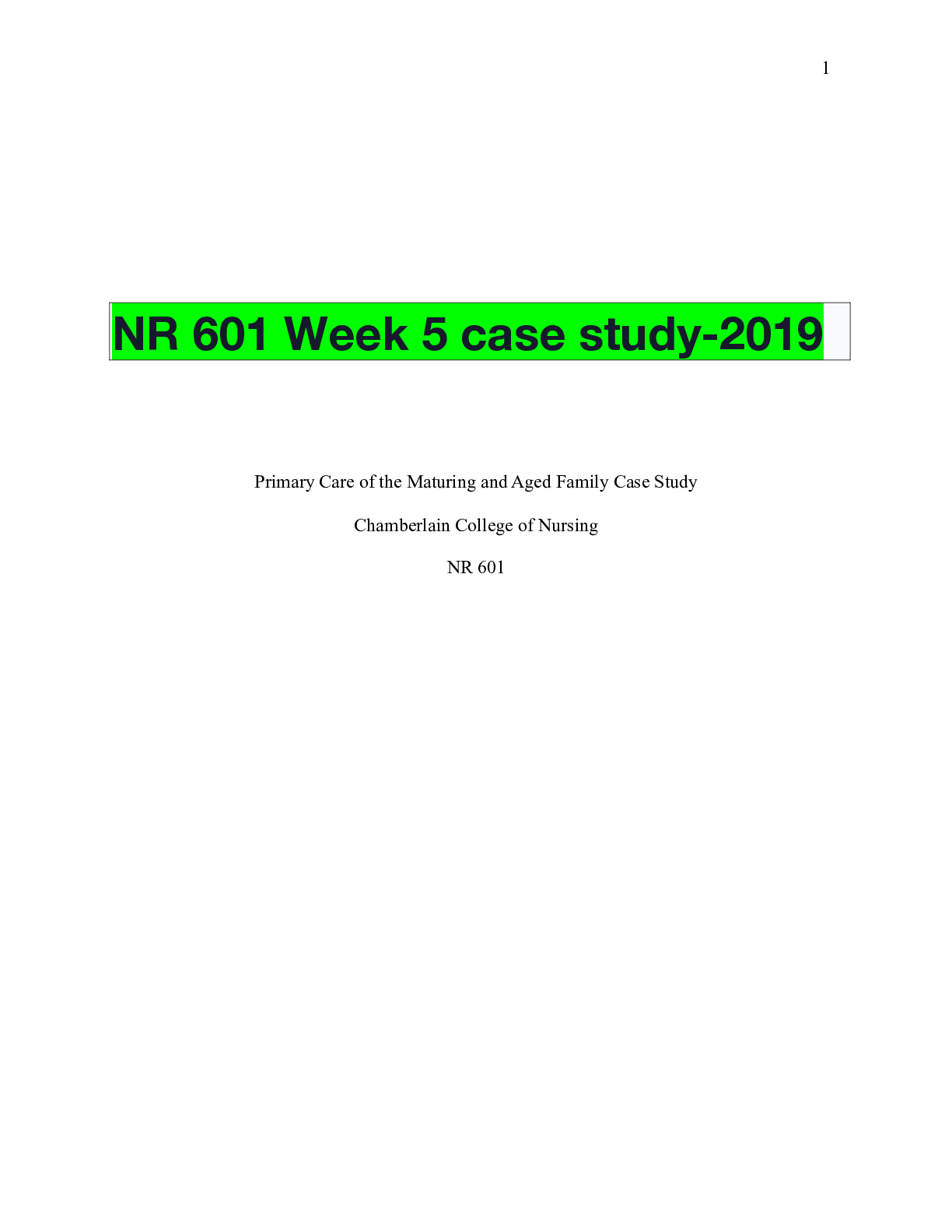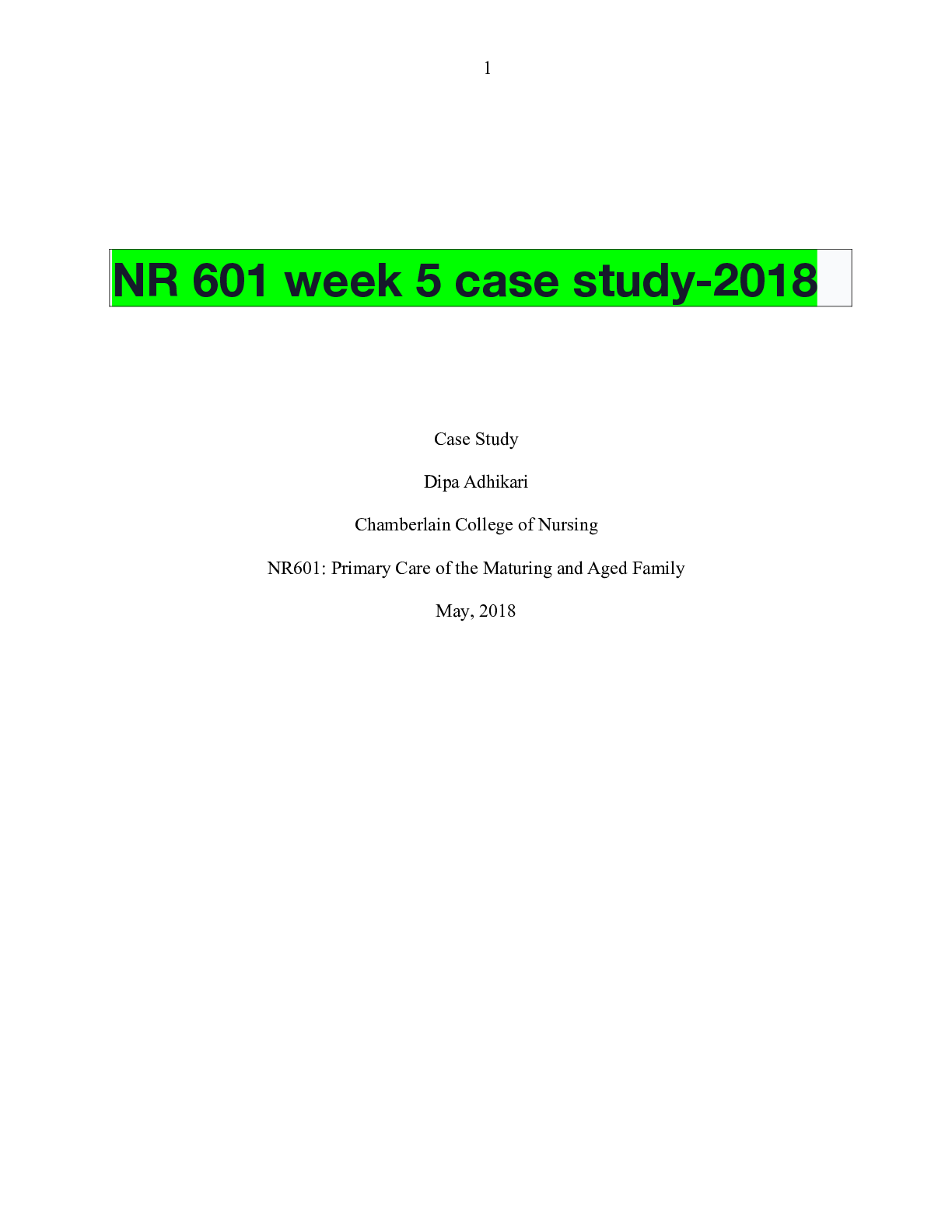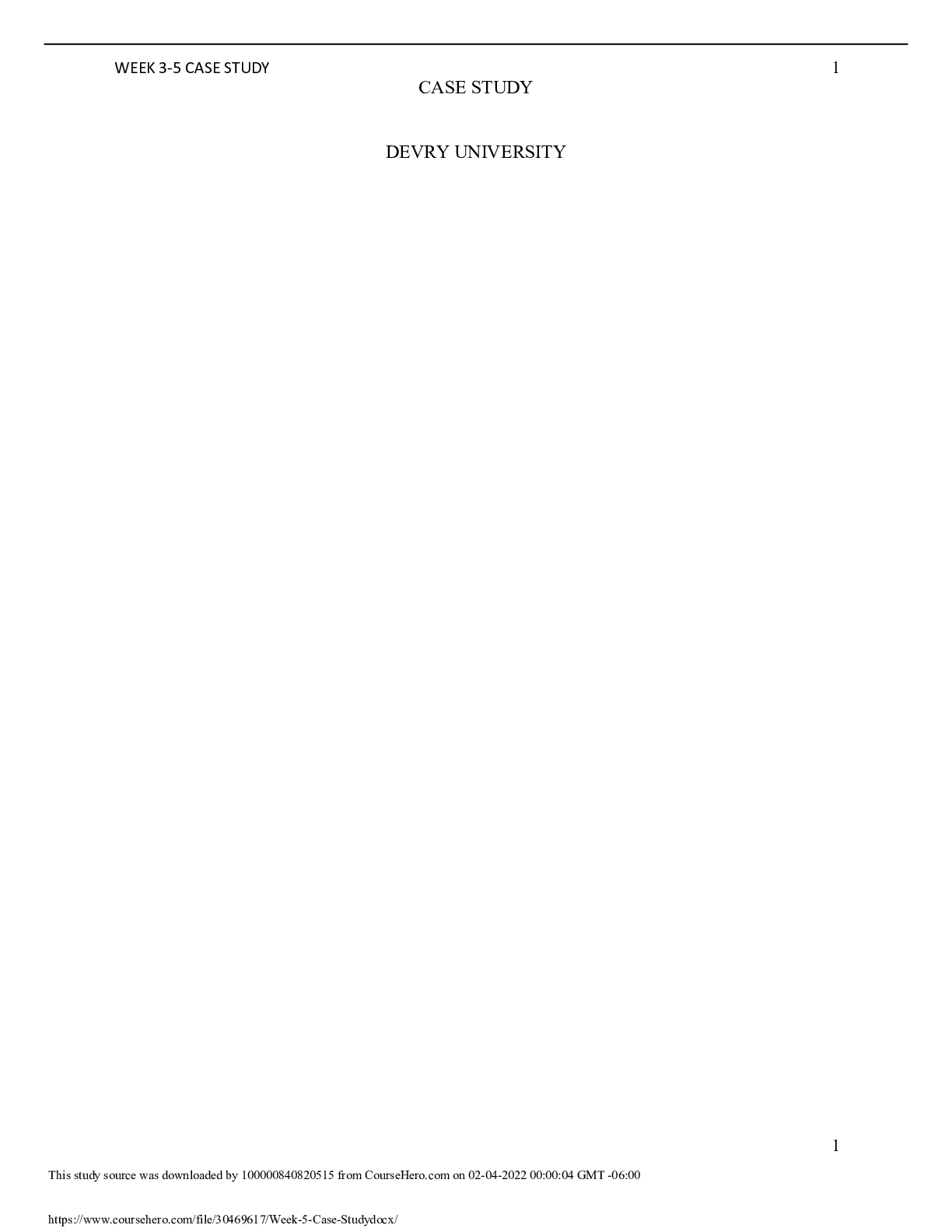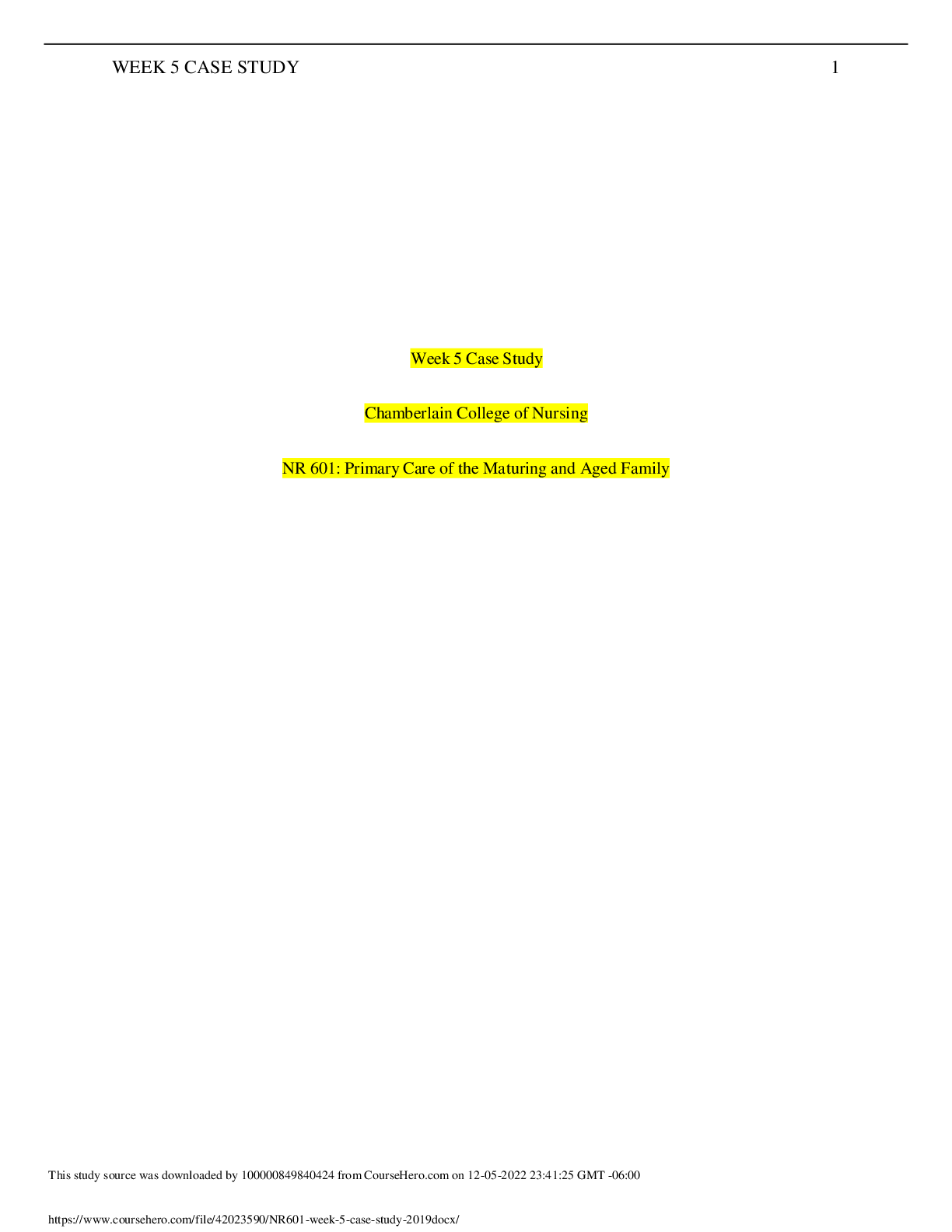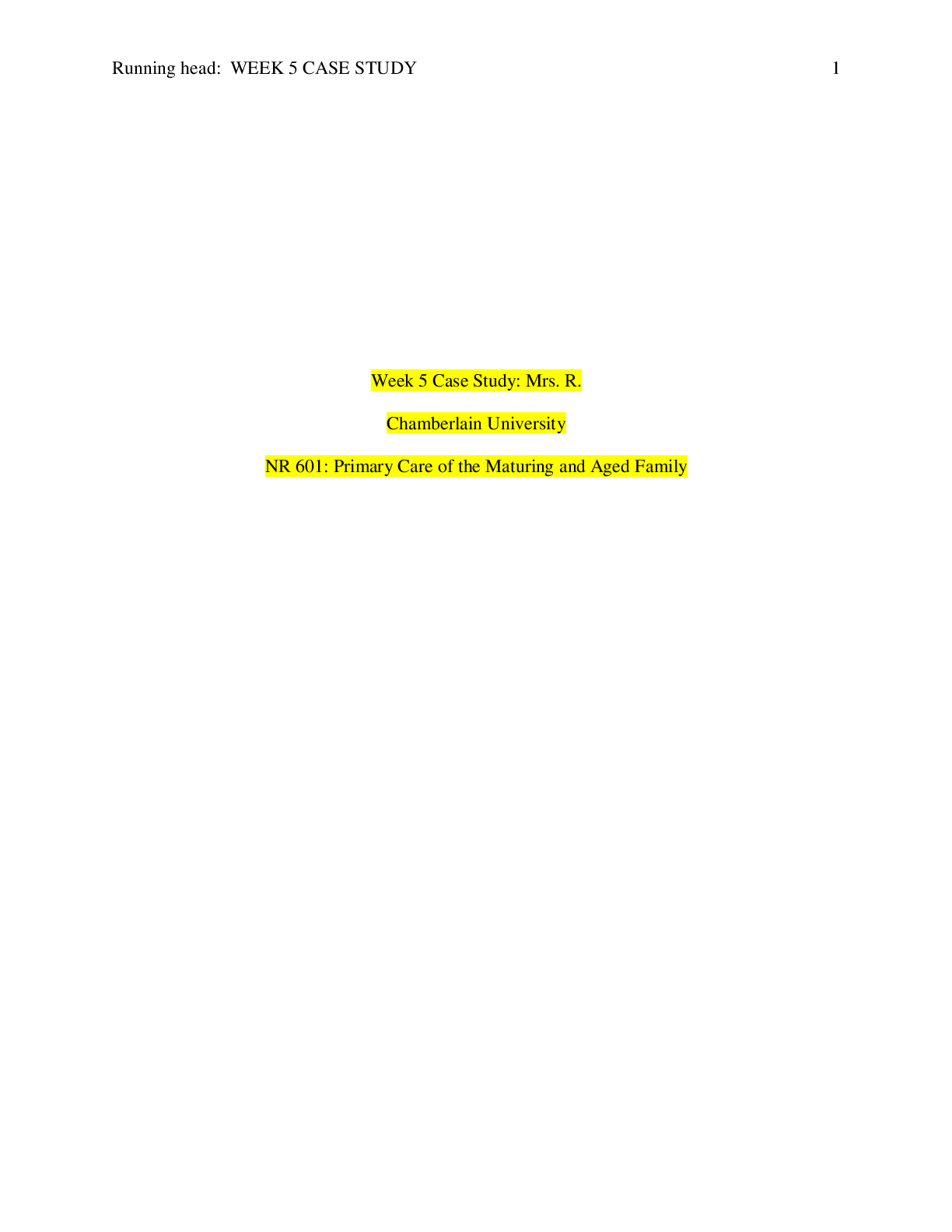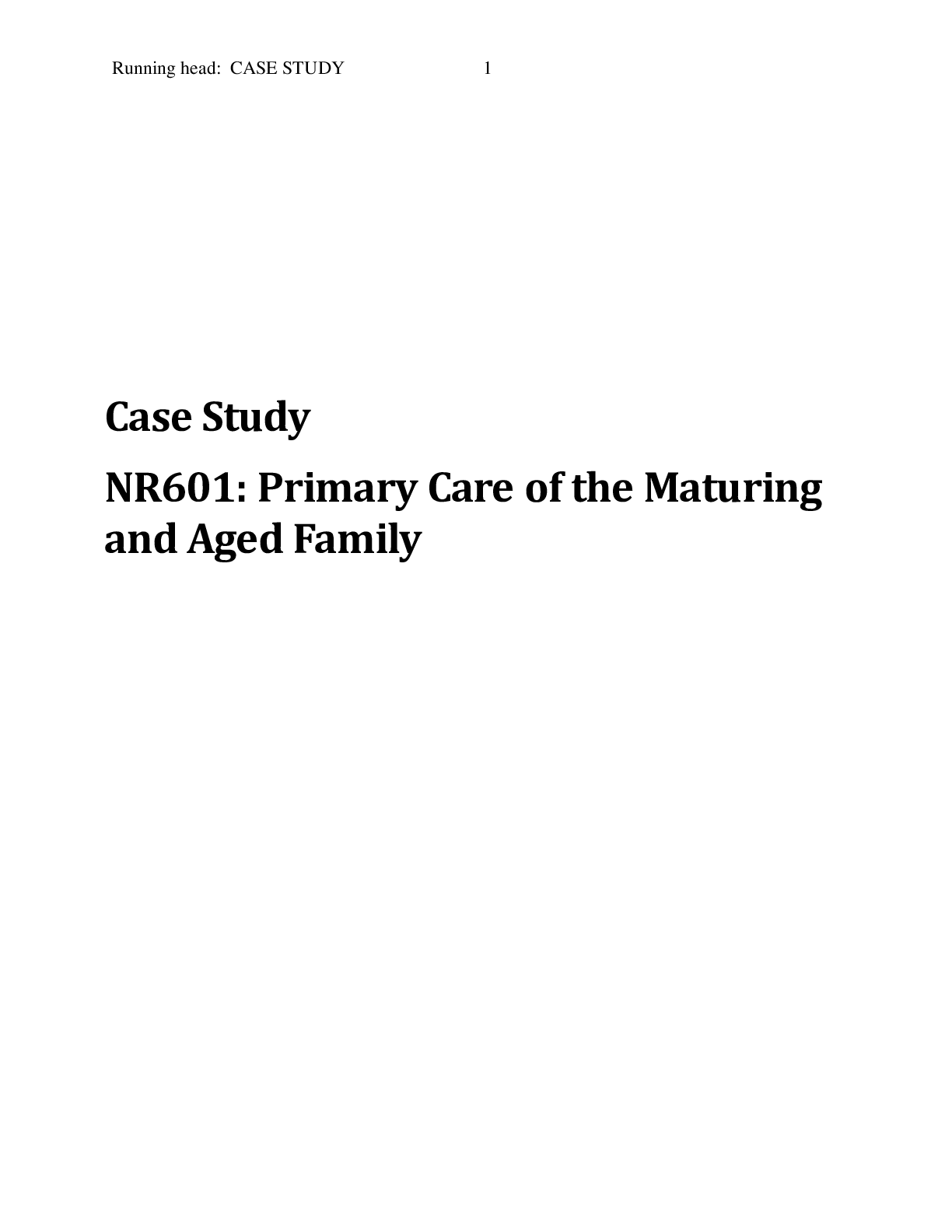*NURSING > CASE STUDY > NR-508 Week 5 Case Study Discussion: Maria is a 46-year (Original Post & Responses) (All)
NR-508 Week 5 Case Study Discussion: Maria is a 46-year (Original Post & Responses)
Document Content and Description Below
NR-508 Week 5 Case Study Discussion: Maria is a 46-year (Original Post & Responses) Total Points Possible: 100 Case Study & Discussion Questions Maria is a 46-year-old woman who presents fo... r her yearly physical examination. Her review of systems is significant for fatigue, constipation and hair loss. Her previous medical history is notable only for obesity. She reports her understanding that she should be on a low calorie, low fat diet with moderate aerobic exercise 4-5 times per week but also notes that having a full-time job and four children makes this difficult to achieve. She has NKDA and takes a multi-vitamin daily. Maria reports a family history of diabetes (mother) and hypertension (brother). She is a nonsmoker. Her diet largely consists of fast food meals. She drinks sweet tea with every meal and an additional 3-4 cups of coffee per day. Previous labs and exam last year are unremarkable. Vitals today: BP 120/70 mm Hg, pulse 76, temperature 98.7, respirations 18, height 5’9”, weight 225 pounds. Urine dip + glucose, fasting plasma glucose 179 mg/dl, HgbA1C is 7.4%, TSH 8.5mU/L and Free T4 0.1 ng/dl. The physical exam is notable for acanthosis nigricans at the neck but otherwise is normal. Dr. Landry and class, What are your treatment goals for Maria? 1. What is your pharmacologic plan and rationale? (cite with appropriate clinical practice guidelines or scholarly, peer-reviewed journals) The patient presents with lab results of TSH level at 8.5mU/L and T4 at 0.1 ng/dl as well as with signs and symptoms of fatigue, constipation, and hair loss. All of these results are consistent with the diagnosis of hypothyroidism. The plan to help address her hypothyroidism is to start the patient on Levothyroxine 50mcg by mouth once daily before breakfast. She will be taking this medication before breakfast as fasting increases the absorption of the medication (Woo & Robsinon, 2018). The patient will start at this dose and depending on repeat lab levels it can be increased by 25 mcg which the lab tests will be performed at a follow-up appointment in 4-6 weeks after the start of medications. When levels are within normal limits TSH 0.3-3.0 mU/L and free T4 9-13 ng/dl the patient can come back for a follow-up appointment every 4-6 months and annually once lab levels are within normal limits. She also presents with HgbA1C being 7.4 %, fasting glucose at 179mg/dl, +glucose in the urine dip test, and acanthosis nigricans which is consistent with the diagnosis for type 2 diabetes. The pharmacological treatment would be to start her on metformin. Biguanides are considered first- line oral treatment to help in lowering glucose in patients with diabetes type 2 (Tan, Alquraini, Mizokami-Stout, & MacEachern, 2016). Metformin can assist in decreasing the HgbA1C by 1.5%-2% and has also been proven to reduce weight, reduce total cholesterol, decrease triglycerides, decrease LDLs, and increase HDLs (Tan, Alquraini, Mizokami-Stout, & MacEachern, 2016). The initial dose is started low and is slowly titrated up to aid in achieving glycemic control. The dose that she will start on will be 500mg orally twice a day. 2. What is the mechanism of action for each drug? Levothyroxine's mechanism of action is that it is a synthetic version of thyroxine (T4) which produces an equivalent effect on the body tissues as the body’s own thyroid hormones (Eghtedari & Correa, 2019). Normally, the hypothalamus secretes the thyrotropin-releasing hormone, which then stimulates the anterior pituitary to secrete thyroid-stimulating hormone (TSH), which then stimulates the thyroid to secrete 80% T4 and 20% T3 hormones (Eghtedari & Correa, 2019). T4 is then converted to its active metabolite T3. The thyroid hormones then work by binding to the thyroid receptor proteins which is contained within the cell nucleus and once inside the nucleus, the thyroid hormones work by influencing DNA to increase the body’s metabolism by increasing gluconeogenesis, protein synthesis, mobilization of glycogen stores, producing negative feedback loop to decrease further secretion of TSH and thyroid hormones,as well as other functions (Eghtedari & Correa, 2019). Metformin’s mechanism of action is it works primarily to decrease hepatic glucose production by decreasing gluconeogenesis and decreases the absorption of glucose in the intestines by increasing target cell insulin sensitivity (Tan, Alquraini, Mizokami-Stout, & MacEachern, 2016). It has multiple effects such as improving long term outcomes and cardiovascular outcomes (Tan, Alquraini, Mizokami-Stout, & MacEachern, 2016). It improves hepatic response to blood glucose levels by allowing the liver to produce appropriate amounts of glucose, increases peripheral glucose uptake and utilization, and it also decreases the intestinal absorption of glucose (Tan, Alquraini, Mizokami-Stout, & MacEachern, 2016). 3. Please give five teaching points for each drug prescribed. Five teaching points for Levothyroxine are • Medication should be taken on an empty stomach with at least 1 hour before eating as this will help to increase the absorption of medication (Biondo, Cappola, & Cooper, 2019). • Call your provider if you are having symptoms such as chest pain, shortness of breath, hypertension, nervousness, tremors, and unexplained weight loss of 2 or more pounds in one week (Biondo, Cappola, & Cooper, 2019). • It is important for the patient to keep up with follow up appointments and have lab testing done as this will indicate if adequate dosing of this medication (Biondo, Cappola, & Cooper, 2019). • If the patient has a heart rate of greater than 100 beats per minute when resting the dose should not be taken and the provider should be notified (Biondo, Cappola, & Cooper, 2019). • If the patient misses a dose then the pill should be taken as soon as the patient remembers and if more than three doses are missed then the health care providers should be informed (Biondo, Cappola, & Cooper, 2019). Five teaching points for Metformin are: • Lab work will be needed to be taken before the initial dose to assess the patient's renal and liver function (Tan, Alquraini, Mizokami-Stout, & MacEachern, 2016). • Notify primary care providers if signs and symptoms of hypoglycemia are experienced such as shakiness, nervousness, sweating, dizziness, and lightheadedness (Tan, Alquraini, Mizokami- Stout, & MacEachern, 2016). • If a dose is missed the patient should take the next dose as soon as they remember but they should not double the dose (Tan, Alquraini, Mizokami-Stout, & MacEachern, 2016). • Metformin can cause low TSH levels in which the patient's Levothyroxine levels should be closely monitored and medications should be adjusted accordingly (Tan, Alquraini, Mizokami-Stout, & MacEachern, 2016). • Daily monitoring of fasting and postprandial blood glucose should be monitored by the patient and they should also have their HbgA1C every 3 months initially and then every 6 months once HbgA1C level is within normal limits (Tan, Alquraini, Mizokami-Stout, & MacEachern, 2016). 4. How would you change the plan if her initial HbgA1C was 10.2mg/dL and her fasting blood glucose was 305mg/dL? Provide a detailed alternative plan with the rationale. If the patient is presenting with an HbgA1C 10.2mg/dL the plan would change by adding insulin to the drug regimen. According to Bloomgarden (2017), insulin therapy is recommended as initial therapy alone or in combination with oral medication when HbgA1C is greater than 9.5 or fasting blood glucose is greater than 250 mg/dL. With this addition of insulin patient education regarding medications, administration, blood glucose monitoring, and lifestyle changes need to be discussed with the patient. The patient should be educated on hypoglycemic effects that can be caused by insulin and the importance of monitoring and keeping track of glucose daily (Bloomgarden, 2017). The patient should be taught how to monitor their glucose and how to inject insulin as the patient will need to rotate the site of injection (Bloomgarden, 2017). References Biondi, B., Cappola, A. R., & Cooper, D. S. (2019). Subclinical Hypothyroidism: A Review. JAMA: Journal of the American Medical Association, 322(2), 153–160. https://doi- org.chamberlainuniversity.idm.oclc.org/10.1001/jama.2019.9052 Bloomgarden, Z (2017). Is insulin the preferred treatment for HbA1c >9%? Journal of Diabetes. 9(9): 814-816. Retrieved from: https://www.ncbi.nlm.nih.gov/pubmed/28589542 Eghtedari B & Correa R. (2019). Levothyroxine. In: StatPearls [Internet]. Treasure Island (FL): StatPearls Publishing; Retrieved from https://www.ncbi.nlm.nih.gov/books/NBK539808/ Moin, T., Schmittdiel, J. A., Flory, J. H., Yeh, J., Karter, A. J., Kruge, L. E., … Walker, E. A. (2018). Review of Metformin Use for Type 2 Diabetes Prevention. American Journal of Preventive Medicine, 55(4), 565–574. https://doi- org.chamberlainuniversity.idm.oclc.org/10.1016/j.amepre.2018.04.038 Tan, M. H., Alquraini, H., Mizokami-Stout, K., & MacEachern, M. (2016). Metformin. 45(4), 819-843. Woo, T. M., & Robinson, M. V. (2016). Pharmacotherapeutics for Advanced Practice Nurse prescribers (4th ed.). Retrieved from http://bookshelf.vitalsource.com [Show More]
Last updated: 1 year ago
Preview 1 out of 5 pages
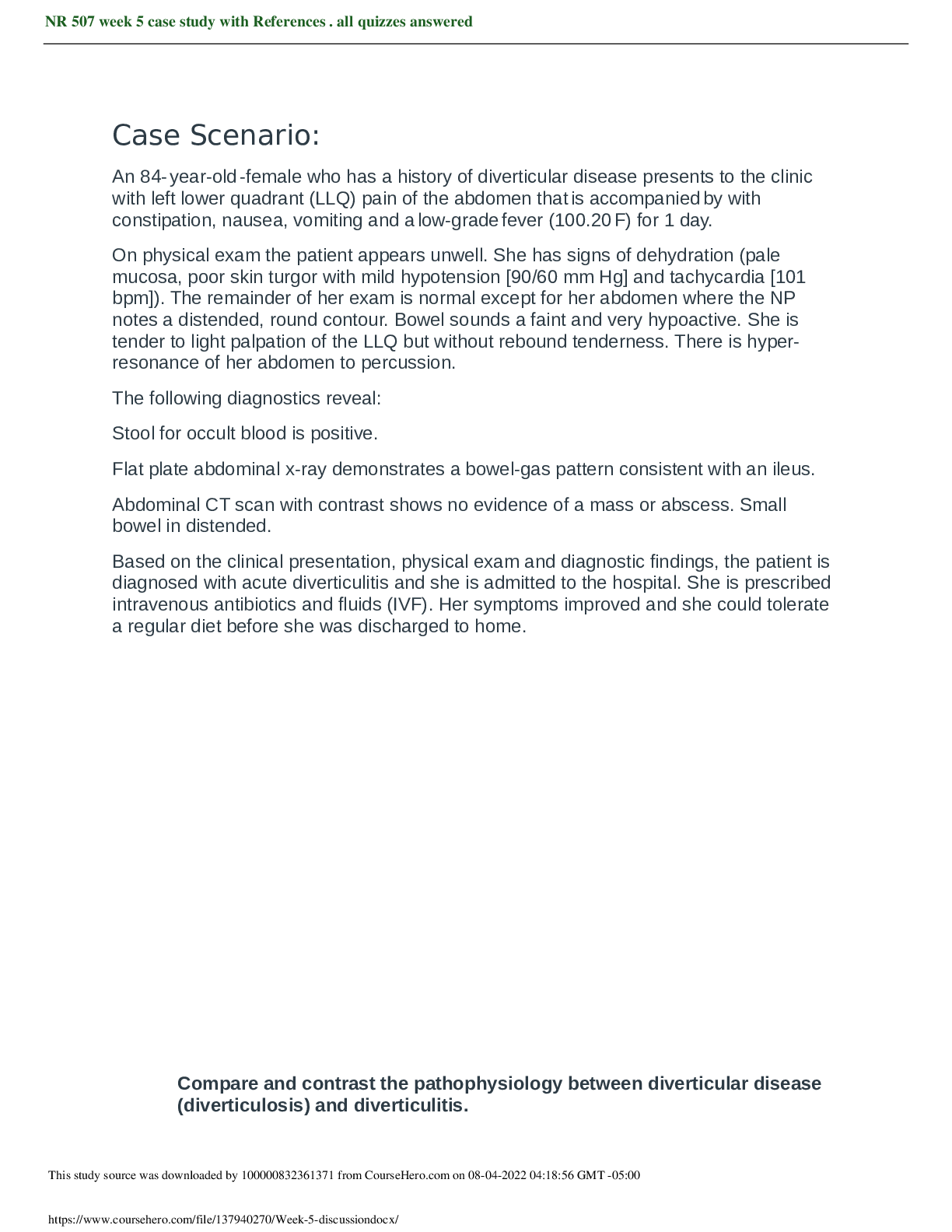
Also available in bundle (1)

NR 508 DISCUSSION TOPIC WEEK 1, CASE STUDY DISCUSSION WEEK 2, 3, 5 BUNDLE | 100% VERIFIED.
NR 508 DISCUSSION TOPIC WEEK 1, CASE STUDY DISCUSSION WEEK 2, 3, 5 BUNDLE | 100% VERIFIED.
By A+ Solutions 2 years ago
$14.5
4
Reviews( 0 )
Document information
Connected school, study & course
About the document
Uploaded On
Nov 11, 2021
Number of pages
5
Written in
Additional information
This document has been written for:
Uploaded
Nov 11, 2021
Downloads
0
Views
49



